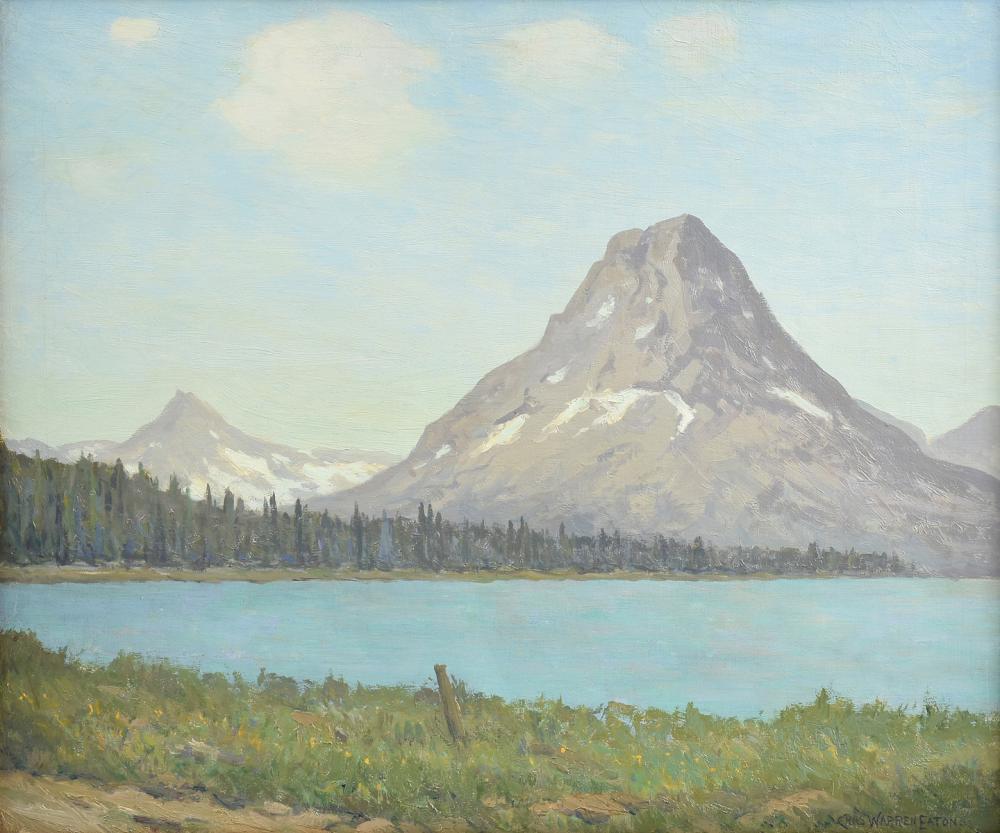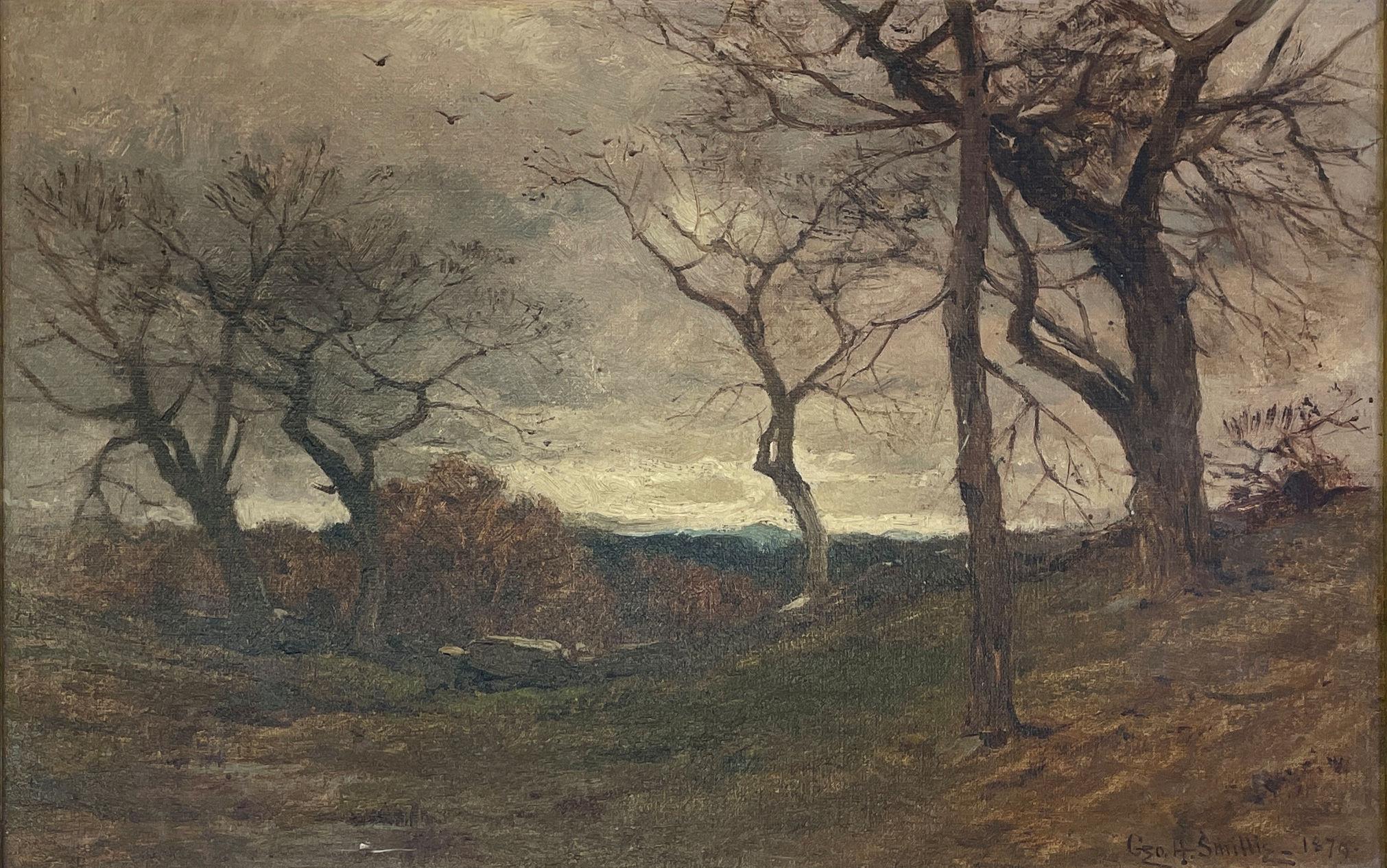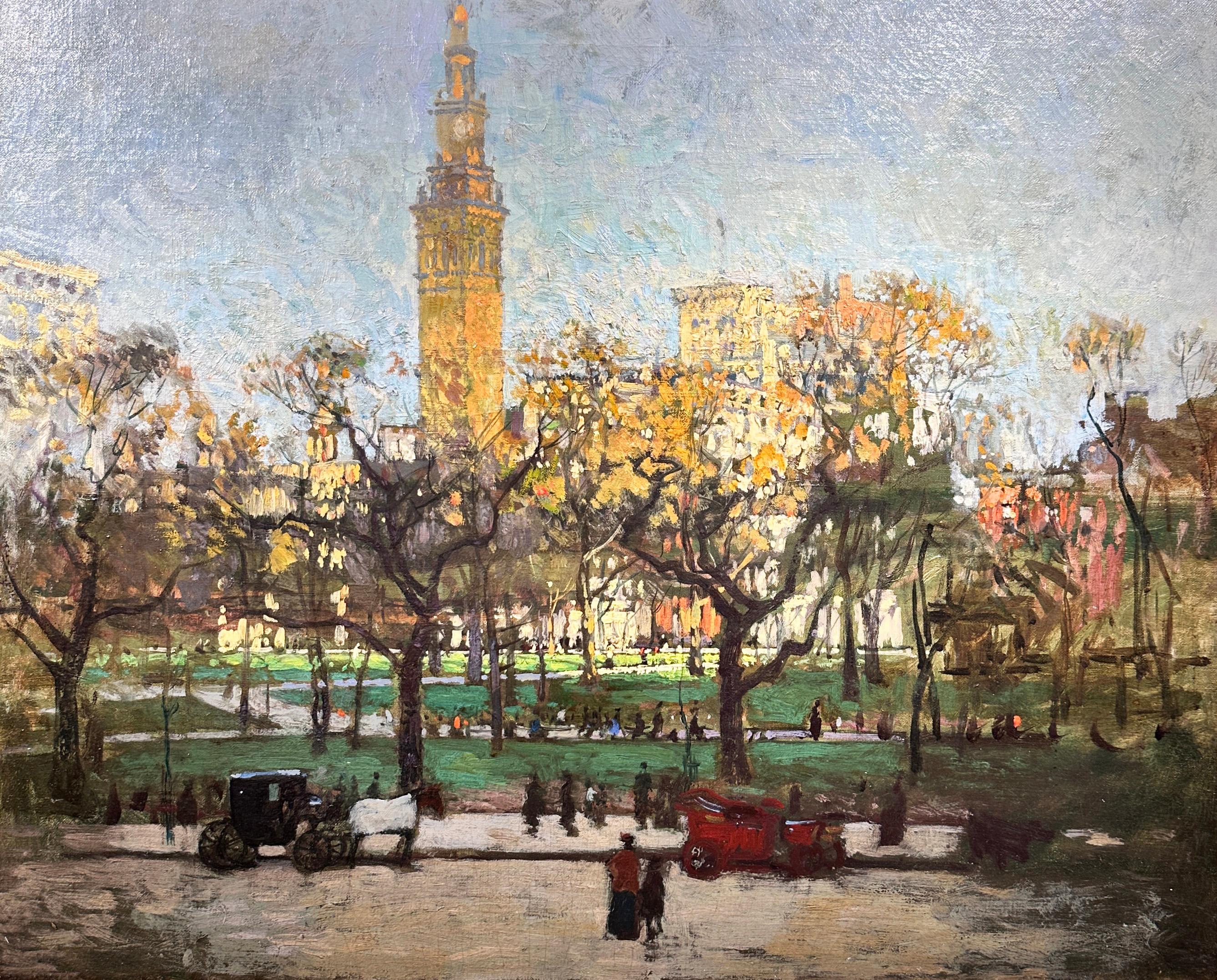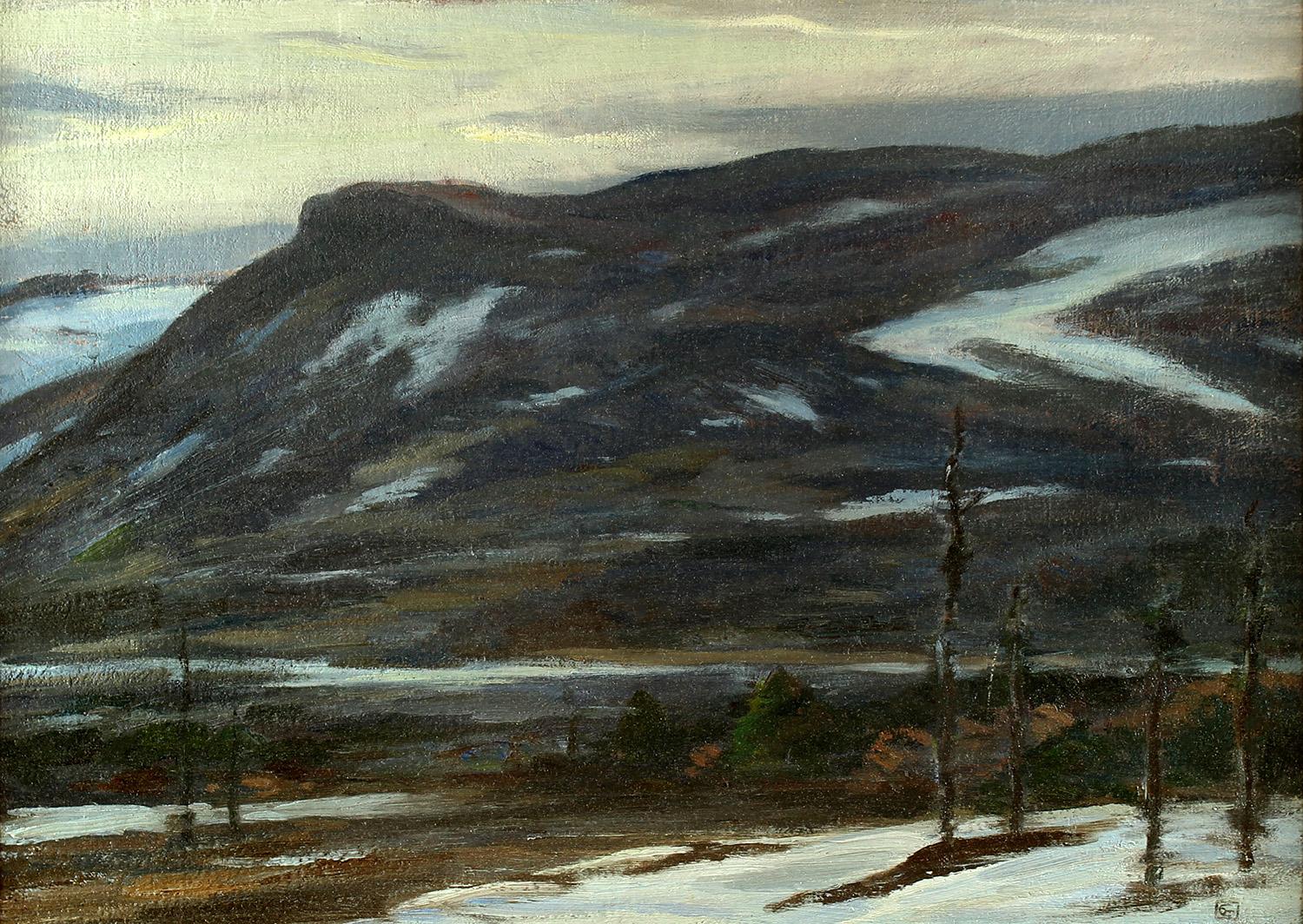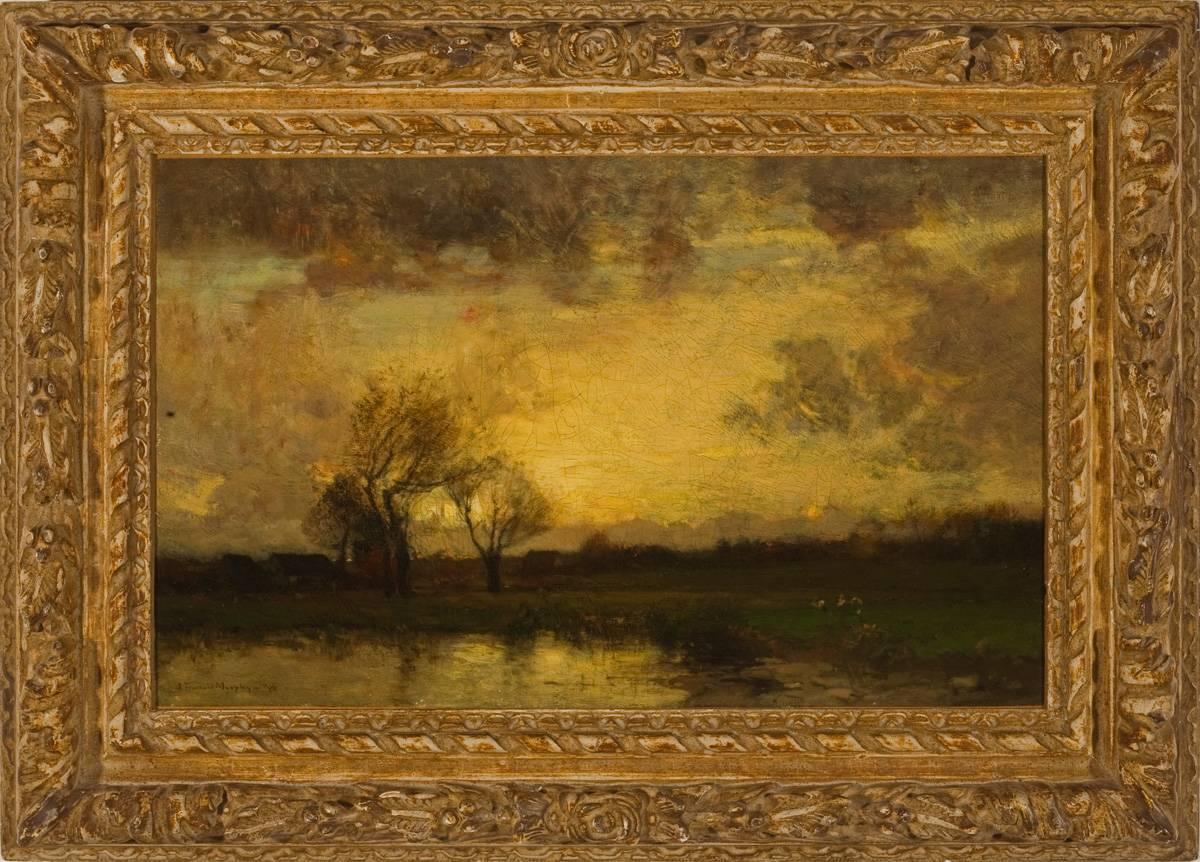Items Similar to "Birches"
Want more images or videos?
Request additional images or videos from the seller
1 of 5
John Francis Murphy"Birches"
About the Item
Jim’s of Lambertville is proud to offer this artwork.
Signed lower left.
John Francis Murphy (1853 - 1921)
John Francis Murphy is increasingly recognized today as one of the leading American Tonalist painters of the nineteenth and early twentieth centuries. Over a productive career of some fifty years, he developed a highly individual aesthetic that was notable for its expressive and poetic nuance. His art attracted a wide following, and was avidly collected by individuals and museums both during his lifetime and in the period following his death.
Murphy was born in Oswego, New York, near Lake Ontario. With his family he moved to Chicago in 1868, where his father was employed in the shipping industry. In Chicago, Murphy began working as a scene painter in a local theatre and was quickly promoted to lead his co-workers. Largely self-taught, his only training consisted of a few classes at the Chicago Academy of Design. There he became friends with Emil Carlsen and Theodore Robinson, and in 1873, Academy members elected him an Associate; a few weeks later, he became an Academician.
- Creator:John Francis Murphy (1853-1921, American)
- Dimensions:Height: 23 in (58.42 cm)Width: 29 in (73.66 cm)Depth: 3 in (7.62 cm)
- Medium:
- Movement & Style:
- Period:
- Condition:
- Gallery Location:Lambertville, NJ
- Reference Number:
About the Seller
5.0
Vetted Seller
These experienced sellers undergo a comprehensive evaluation by our team of in-house experts.
Established in 1997
1stDibs seller since 2014
Typical response time: 6 hours
- ShippingRetrieving quote...Ships From: Lambertville, NJ
- Return PolicyThis item cannot be returned.
More From This SellerView All
- "Landscape with Trees and Pond"By John Francis MurphyLocated in Lambertville, NJJim’s of Lambertville is proud to offer this artwork. Signed and Dated Lower Left John Francis Murphy (1853 - 1921) John Francis Murphy is increasingly recognized today as one o...Category
1890s Tonalist Landscape Paintings
MaterialsOil, Canvas
- "Fall Landscape"By John Francis MurphyLocated in Lambertville, NJJim’s of Lambertville is proud to offer this artwork by: John Francis Murphy (1853 - 1921) John Francis Murphy is increasingly recognized today as one of the leading American Tonal...Category
Early 1900s Tonalist Landscape Paintings
MaterialsCanvas, Oil
- "Landscape with Farm"By John Francis MurphyLocated in Lambertville, NJJim’s of Lambertville is proud to offer this artwork by: John Francis Murphy (1853 - 1921) John Francis Murphy is increasingly recognized today as one of the leading American Tona...Category
1890s Tonalist Landscape Paintings
MaterialsCanvas, Oil
- "The Low Lands"By John Francis MurphyLocated in Lambertville, NJJim’s of Lambertville is proud to offer this artwork. Signed and Dated Lower Left John Francis Murphy (1853 - 1921) John Francis Murphy is increasingly recognized today as one o...Category
Early 1900s Tonalist Landscape Paintings
MaterialsOil, Canvas
- "An Old Clearing"By John Francis MurphyLocated in Lambertville, NJJim’s of Lambertville is proud to offer this artwork. Signed and dated lower left. John Francis Murphy (1853 - 1921) John Francis Murphy is increasingly recognized today as one o...Category
1910s Tonalist Landscape Paintings
MaterialsOil, Canvas
- "The Canal"By Edward Willis RedfieldLocated in Lambertville, NJJim’s of Lambertville is proud to offer this artwork. Signed lower left. Complemented by a hand carved and gilt frame. Illustrated in "Edward Redfield: Just Values and Fine Seeing" by Constance Kimmerle and the Pennsylvania Academy of the Fine Arts's Exhibition of Paintings by Edward Redfield (April 17 to May 16, 1909) brochure Edward Willis Redfield (1869 - 1965) Edward W. Redfield was born in Bridgeville, Delaware, moving to Philadelphia as a young child. Determined to be an artist from an early age, he studied at the Spring Garden Institute and the Franklin Institute before entering the Pennsylvania Academy from 1887 to 1889, where he studied under Thomas Anshutz, James Kelly, and Thomas Hovenden. Along with his friend and fellow artist, Robert Henri, he traveled abroad in 1889 and studied at the Academie Julian in Paris under William Bouguereau and Tony Robert-Fleury. While in France, Redfield met Elise Deligant, the daughter of an innkeeper, and married in London in 1893. Upon his return to the United States, Redfield and his wife settled in Glenside, Pennsylvania. He remained there until 1898, at which time he moved his family to Center Bridge, a town several miles north of New Hope along the Delaware River. Redfield painted prolifically in the 1890s but it was not until the beginning of the twentieth century that he would develop the bold impressionist style that defined his career. As Redfield’s international reputation spread, many young artists gravitated to New Hope as he was a great inspiration and an iconic role model. Edward Redfield remained in Center Bridge throughout his long life, fathering his six children there. Around 1905 and 1906, Redfield’s style was coming into its own, employing thick vigorous brush strokes tightly woven and layered with a multitude of colors. These large plein-air canvases define the essence of Pennsylvania Impressionism. By 1907, Redfield had perfected his craft and, from this point forward, was creating some of his finest work. Redfield would once again return to France where he painted a small but important body of work between 1907 and 1908. While there, he received an Honorable Mention from the Paris Salon for one of these canvases. In 1910 he was awarded a Gold Medal at the prestigious Buenos Aires Exposition and at the Panama-Pacific Exposition of 1915 in San Francisco, an entire gallery was dedicated for twenty-one of his paintings. Since Redfield painted for Exhibition with the intent to win medals, his best effort often went into his larger paintings. Although he also painted many fine smaller pictures, virtually all of his works were of major award-winning canvas sizes of 38x50 or 50x56 inches. If one were to assign a period of Redfield’s work that was representative of his “best period”, it would have to be from 1907 to 1925. Although he was capable of creating masterpieces though the late 1940s, his style fully matured by 1907 and most work from then through the early twenties was of consistently high quality. In the later 1920s and through the 1930s and 1940s, he was like most other great artists, creating some paintings that were superb examples and others that were of more ordinary quality. Redfield earned an international reputation at a young age, known for accurately recording nature with his canvases and painting virtually all of his work outdoors; Redfield was one of a rare breed. He was regarded as the pioneer of impressionist winter landscape painting in America, having few if any equals. Redfield spent summers in Maine, first at Boothbay Harbor and beginning in the 1920s, on Monhegan Island. There he painted colorful marine and coastal scenes as well as the island’s landscape and fishing shacks. He remained active painting and making Windsor style furniture...Category
Early 1900s American Impressionist Landscape Paintings
MaterialsCanvas, Oil
You May Also Like
- "Mount Rockwell, Glacier National Park, Montana, " Mountain Lake Landscape ViewBy Charles Warren EatonLocated in New York, NYCharles Warren Eaton (1857 – 1937) The Shadow of Mount Rockwell, Glacier National Park, Montana, 1921 Oil on canvas 20 x 24 inches Signed lower right: CHAS WARREN EATON. Provenance: The artist The Macbeth Gallery, New York Private Collection Sotheby's New York, American Art, April 14, 1989 ConocoPhillips, Houston Simpson Galleries, Houston, Fine Art & Antiques, May 18, 2019, Lot 447 Exhibited: New York, The Macbeth Gallery, Paintings of Glacier National Park by Charles Warren Eaton, December 13, 1921 - January 2, 1922, no. 2. Literature: "Two Exhibitions at Macbeth's," American Art News, New York, Vol. XX, No. 10, December 17, 1921. A contemporary critic wrote that the paintings of Charles Warren Eaton appeal to “the dreamers who find in them the undiscovered scenes in which their fancy long has dwelt.” Eaton’s contemplative landscapes exude a spiritual quality that moves the observer into a similar frame of mind. He loved to depict the ethereal light of dawn and dusk in late autumn or winter, usually without any reference to human or animal figures or buildings. These Tonalist paintings, with their subdued palette and relatively intimate scale, marked a definite break with the fading popularity of the panoramic and romantic views of the Hudson River School painters. Charles Warren Eaton was born in Albany, New York to a family of limited means. He began painting while working in a dry-goods store. At age 22, he enrolled at the National Academy of Design in New York City and then studied figure painting at the Art Students League. By 1886, he was successful enough to quit his day job and make a living as a landscape painter. That year, he traveled to Europe with fellow Tonalist painters Leonard Ochtman and Ben Foster. In France, Eaton visited popular artist’s spots such as Paris, Fontainebleau and Grez-sur-Loing, and fell in love with the loose brushwork and moody style of French Barbizon painting. Returning to the United States, Eaton fell under the spell of George Inness, the foremost exponent of Barbizon style in the United States. In 1888, Eaton settled near Inness in Bloomfield, New Jersey, where Eaton lived until his death in 1937. In this period, he painted shadowy and ambiguous landscapes inspired by rural scenery in the northeastern United States. His signature theme was a cropped view of the branches, trunks, and foliage of a pine grove silhouetted against a delicately illuminated sunset or moonlit sky. He painted this vision so often between 1900 and 1910 that he picked up the sobriquet ‘‘The Pine Tree Painter.” After 1910, Eaton responded to the popularity of Impressionism by using brighter colors and painting sunlit daytime scenes. In 1921, he was hired to paint Glacier Lake, in Glacier National Park by the Great Northern Railroad Company as part of their ‘See America First’ campaign. He produced more than 20 paintings, among the artist's last works, that now poignantly remind viewers of the vast disappearing glaciers. Eaton tended to approach this mountain scenery from an oblique vantage point; he liked to capture small episodes, showing mountaintops nearly obscured by dramatically attenuated screens of fir trees. Eaton, like many Tonalist artists of his generation such as Henry Ward Ranger, John Francis Murphy, and Charles Melville Dewey...Category
1920s Tonalist Landscape Paintings
MaterialsCanvas, Paint, Oil
- "Stone Wall, Autumn, " George Smillie, Tonalist Fall Landscape ViewBy George Henry SmillieLocated in New York, NYGeorge Henry Smillie (1840 - 1921) Stone Wall, Autumn, 1879 Oil on canvas 9 1/2 x 15 inches Signed and dated lower right Provenance: Skinner, Boston, September 19, 2014, Lot 389 The career of George Smillie (1840-1921) followed the arc of nineteenth-century U.S. landscape painting. Trained in the Hudson River School tradition, Smillie successfully adapted to changing U.S. tastes and growing interest in European trends. In the late 1800s, he moved to tonalist paintings full of brushwork and influenced by French Barbizon painting. By the end of his career, he had lightened his palette to produce works similar to those of the U.S. impressionists. Yet in all styles, he was never less than competent, and his tonalist work is among the best produced in the United States. Like many nineteenth-century painters, George Smillie’s artistic training began with the study of printing. His father, James Smillie...Category
1870s Tonalist Landscape Paintings
MaterialsOil, Canvas
- Indian EncampmentBy Ralph Albert BlakelockLocated in New York, NYSigned lower left in arrowhead: R.A. Blakelock (NBI-1611-II)Category
Late 19th Century Tonalist Landscape Paintings
MaterialsCanvas, Oil
- Afternoon, Madison SquareBy Paul CornoyerLocated in Missouri, MOPaul Cornoyer (American, 1864-1923) "Afternoon, Madison Square" (New York City) 1908 Oil on Canvas Signed/Titled Verso on Stretcher Bar Unframed: 22 x 27 inches Framed: 32.5 x 38 inches Exhibition Label Verso (Presumably Newhouse Galleries, St. Louis...Category
Early 1900s Tonalist Landscape Paintings
MaterialsCanvas, Oil
- Wind River - WyomingBy Eliot ClarkLocated in New York, NYWind River- Wyoming by Eliot Clark (1883-1980) Oil on canvas, linen relined 14 x 20 inches unframed (35.56 x 50.8 cm) 18 ¼ x 24 inches framed (46.355 x 60.9...Category
20th Century Tonalist Landscape Paintings
MaterialsCanvas, Linen, Oil
- "Mountain Labyrinths"By John F. CarlsonLocated in Lambertville, NJAshley John is proud to offer this artwork by: John Fabian Carlson (1874/75 - 1945) John F. Carlson was one of the leading American landscape p...Category
Early 20th Century Tonalist Landscape Paintings
MaterialsCanvas, Oil
